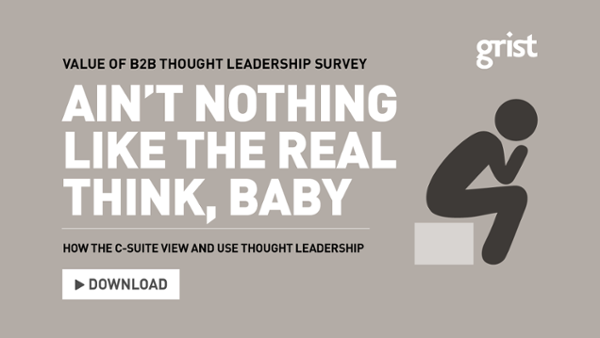We hear a lot about thought leadership these days, but so much of it is a misnomer. When the term was first coined by Joel Kurtzman, editor of strategy+business, in 1994, he was referring to the publication’s interviewees as people with “ideas that merited attention”.
Today, companies far and wide are creating basic content marketing and slapping a ‘thought leadership’ label on it, cheapening the brand. Which is what makes thought leadership even more essential today.
Grist defines thought leadership as “original, authoritative and insightful content that differentiates your brand and helps your clients, leading to mutually beneficial commercial opportunities”. It helps to define your brand, to bring attention to your vision, to set your people up as experts and ultimately generates leads.
Still, thought leadership suffers from its association with cheap and cheerful content production, especially in the B2B world. Why should a brand invest in research-driven thought leadership – something that takes time and effort – when they could pump out quick content for SEO or campaigns?
The thing about thought leadership – true, top quality, well-done thought leadership – is that it’s something senior business leaders crave.
Our research shows thought leadership helps to inform their decisions when appointing advisers, to guide their thinking about strategy and partners, and to keep them up to date with industry movements.
Here are five reasons why we believe B2B organisations should give serious consideration to investing in thought leadership, backed by robust data from our recent Value of B2B Thought Leadership survey.
1. Thought leadership is critical to decision-making and appointments
Almost all senior executives – that’s 99% – claim thought leadership is either critical or important to their decision-making when appointing an adviser.
It should be supported by anecdotal evidence – take RFPs, for example. It used to be that thought leadership would help your proposal to stand out from the crowd; now it’s an expected part of the process.
2. Senior executives actually want to read (quality) thought leadership
You create thought leadership because you want to reach the C-suite, right? Guess what – they actually want to hear from you, too.
More than one-third (34%) of those we spoke with want to hear from advisory firms that specialise in an issue. By creating thought leadership with original opinions on an industry trend, you can get the attention of the very people you want to sell to.
3. Without it, you’ll miss out on leads
Because yes, thought leadership generates leads if you can make it compelling and know how to stand out from the crowd.
Senior leaders read one-third of the thought leadership they come across. To make sure your content isn’t in the other two-thirds, it’s best to include strong analysis backed by robust data – those are the qualities most sought by the C-suite in thought leadership.
4. Quality, relevant thought leadership = business opportunities
If your thought leadership rises to the top of the pile, it could lead to a call from the senior business leader themselves – 26% of the C-suite that reads thought leadership will end up reaching out to the firm that created it. Targeted, quality content could bring you ROI unlike any other marketing tactic.
5. One piece of thought leadership can fuel a year’s marketing
Don’t judge a survey-driven thought leadership programme by the price tag; look instead to what it can do for you.
We’ve established that thought leadership can act as a direct line to the top decision-makers in a business, but it can also feed your other marketing tactics.
Whether it’s the 43% of readers who will go on to review related articles, or the 33% who would attend an event by the firm that produced the thought leadership, it’s clear this is not just a one-trick pony.
Quality thought leadership can even fuel an entire year’s worth of content marketing or a targeted campaign. When effectively planned, one piece of survey-driven thought leadership suddenly becomes so much more valuable than the data you get out of it.
The C-suite wants your thought leadership
It’s not just our results that shows senior business leaders want to read quality thought leadership – recent data from LinkedIn says 58% of C-suite decision-makers consider thought leadership while evaluating businesses to work with.
The social business platform also teamed with Edelman Digital in 2017 to ask the same question, and found 39% of decision-makers said thought leadership had influenced them to ask a vendor to participate in the RFP process, while 47% said it has a direct impact on awarding business.
But don’t be caught out by these promising statistics; to ensure your thought leadership hits this mark, that it’s not just content masquerading as quality insights, it’s best to create original research based on a hypothesis that’s relevant to your audience.
With effective planning and targeting, you can elevate thought leadership from slush pile to yes pile and create real, tangible business results in the process.



